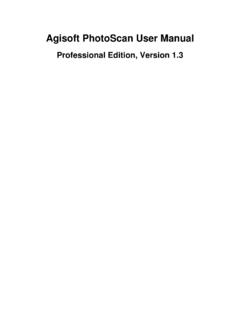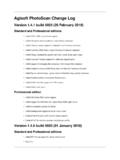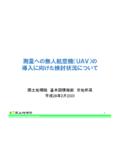Transcription of Evaluation of UAV Photogrammetric Accuracy for …
1 G E O M A T I C A. Evaluation OF UAV Photogrammetric . Accuracy FOR MAPPING AND. EARTHWORKS COMPUTATIONS. Chris Cryderman, S. Bill Mah, Aaron Shufletoski Underhill Geomatics Ltd., Canada This study quantifies the accuracies achieved and tests the validity of an in-house developed Unmanned Aerial Vehicle (UAV) system employed in a stockpile volumetric survey. UAV Photogrammetric results are Geomatica Downloaded from by Christopher Cryderman on 03/20/15. compared with conventional GNSS survey results. To test the repeatability of the UAV system, multiple flights were flown over the same stockpile using different GNSS ground control, at different times and weather conditions. Positional accuracies of UAV Photogrammetric results were found to be very similar to those from GNSS RTK survey, at the scale of photography flown. UAV stockpile volume results agreed with those from GNSS within 3 755 m3 ( ) on a 530 255 m3 pile.
2 Stockpile volume comparisons between subsequent UAV surface models agreed within 877 m3 ( ) on the same pile. Geometric analysis of independent UAV Photogrammetric models over the same area indicated that they could be considered the Chris Cryderman same at a 95% confidence level. We conclude that the UAV Photogrammetric approach is, at the very least, equivalent in Accuracy to GNSS RTK surveys at the scale of photography observed. The Accuracy of the UAV Photogrammetric surveys were sufficient for 1:200 scale mapping and m contours. The UAV. Photogrammetric approach also provided greater detail, resulting in more representative models of the For personal use only. measured surfaces. Cet article quantifie les pr cisions obtenues et v rifie la validit d'un syst me de v hicules a riens sans pilote (UAV) d velopp l'interne et utilis lors d'un relev volum trique d'une aire de stockage. Les r sultats photogramm triques du syst me d'UAV sont compar s des r sultats de relev s du GNSS conventionnels.
3 Pour v rifier la reproductibilit du syst me d'UAV, de nombreux vols ont t effectu s au-dessus de la m me aire de stockage en utilisant diff rents contr les au sol du GNSS, diff rents moments et dans diverses conditions m t orologiques. Les pr cisions positionnelles des r sultats photogramm triques du syst me d'UAV se sont r v l es tr s similaires celles des relev s cin matiques en temps r el du GNSS S. Bill Mah l' chelle des photographies r alis es. Les r sultats du volume de l'aire de stockage du syst me d'UAV concordent avec ceux du GNSS avec un cart de l'ordre de 3 755 m3 (0,7 %) pour une aire de stockage de 530 255 m3. Les comparaisons du volume de l'aire de stockage entre les mod les de surface du syst me d'UAV subs quents concordaient avec un cart de l'ordre de 877 m3 (0,2 %) pour la m me aire. Les analyses g om triques de mod les photogramm triques ind pendants du syst me d'UAV pour la m me aire indiquaient qu'ils pourraient tre consid r s comme tant les m mes avec un degr de confiance de 95 p.
4 Cent. Nous concluons que l'approche photogramm trique du syst me d'UAV est, tout le moins, quivalente sur le plan de la pr cision aux relev s cin matiques en temps r el du GNSS l' chelle des photographies observ es. La pr cision des relev s photogramm triques du syst me d'UAV tait suffisante pour une chelle cartographique de 1/200 et des courbes de niveau de 0,145 m. L'approche photogramm - trique du syst me d'UAV a galement fourni de meilleurs d tails, permettant ainsi d'obtenir des mod les plus repr sentatifs des surfaces mesur es. Aaron Shufletoski Introduction An Unmanned Aerial Vehicle (UAV), equipped the UAV. Weight and aversion to risk limits the at- with a digital camera, can be a cost-effective plat- risk payload. Consequently, small UAVs such as form for large scale aerial mapping. Its suitability to the one described in this paper are, by their very the task is dependent on a number of factors, includ- nature, a compromise.
5 Ing the extent of the area to be mapped, required In this paper, we compare the Accuracy of UAV. Accuracy and regulatory constraints. Regulations photogrammetry with conventional ground survey dictate the maximum weight and flying height of methods on a large stockpile. We also compare the GEOMATICA Vol. 68, No. 4, 2014 pp. 309 to 317. G E O M A T I C A. repeatability of UAV Photogrammetric surveys over the same area. The UAV used in this study was developed in-house and had a non-metric consumer camera as its payload. Review of Literature This study is not the first to look at the Accuracy of UAV Photogrammetric mapping employing a non-metric camera. With the advent of commercial Geomatica Downloaded from by Christopher Cryderman on 03/20/15. UAVs and highly automated bundle adjustment software, the push to prove the platform for aerial Figure 1: The study UAV. mapping applications has been relentless.
6 Draeyer et al. [2014] and Strecha [2014] compared non- metric UAV photogrammetry with GNSS RTK and terrestrial LiDAR for stockpile volumes. Their tests employed a 16 megapixel Canon IXUS consumer camera in a small fixed-wing UAV. Volume com- parisons with the UAV survey, for 16 000 m3. stockpiles, were found to be within 2 3% for GNSS, and for terrestrial LiDAR. Comparison of the For personal use only. surfaces was done in elevation only. At a Ground Sample Distance (GSD) of 5 cm, elevation differ- ences between the tested methods of 2 4 cm with standard deviations of 7 17 cm were observed. Wang [2014] utilized a Canon 5D Mark II, 21. megapixel DSLR consumer camera in a multi-rotor UAV for their similar comparisons. They deter- mined the mean square errors of 12 GNSS Ground Control Points (GCPs) with UAV mapped positions to be x = 7 cm, y = 8 cm, z = 2 cm. Comparison Figure 2: UAV autopilot, sensor, and radio packages.
7 Of UAV photogrammetry and terrestrial LiDAR. point clouds was done on 5 cm resampled Triangulated Irregular Networks (TINs). Maximum deviations were stated to lie from to m, with most deviations being within m. The large deviations were attributed to surface movement. The estimated Accuracy of volume computation was All of the above was at a GSD of 1 cm. UAV Platform and Image Acquisition Payload The UAV used in this study was an in-house developed m fixed-wing, single engine, carbon fibre reinforced, EPO foam model (Figure 1). UAV. auto-navigation and camera shutter triggering was accomplished with an APM autopilot. The Figure 3: UAV payload Samsung NX1000 with Carl Zeiss APM autopilot incorporates a number of sensors, 18mm lens. including L1-code GPS receiver, flux-gate compass, 310. G E O M A T I C A. 3-axis MEMS gyros and accelerometers, barometer, and air speed sensor. Full manual flight control was provided via standard RC-transmitter, with backup and telemetry available via a secondary telemetry radio and ground tablet computer (Figure 2).
8 [Mah 2014]. The payload was an uncalibrated, consumer grade Samsung NX1000 mirrorless camera with a Carl Zeiss 18 mm focal length, full frame (35 mm). lens (Figure 3). The camera sensor was a 20. megapixel CMOS APS-C format. Camera calibra- tion was accomplished, post-mission, in the bundle Geomatica Downloaded from by Christopher Cryderman on 03/20/15. adjustment software. The use of a full frame lens on a cropped sensor camera reduced the portion of the lens that is actually involved in creating the image. Figure 4: GNSS RTK surveyed 220 point mesh of 372 faces. This resulted in a sharper image and greatly reduced vignetting. To minimize changes in the cal- ibration of the camera during the mission, the lens was set at a fixed aperture (f ), and the focus was fixed at the corresponding hyperfocal distance ( m). The resulting depth of field was m to infinity. Piezoelectric sensor cleaning was turned off.
9 The ISO was set at 800 which, for this particu- For personal use only. lar sensor, results in a minimal increase in image noise. Shutter speeds varied from 1/1000 to 1/4000 of a second [Mah 2014]. UAV Field Accuracy Test . Stock Pile Figure 5: Portion of image showing targets 9 and 1 from a 90-m height above the top of the pile. To test the Accuracy and repeatability of the UAV aerial mapping system, a stock pile that had been surveyed previously was chosen. An updated GNSS RTK survey was performed, defining the shape of the pile utilizing a TIN, or mesh, and break-lines defining major changes in slope. This is an accepted and common method of detail topo- graphic surveying and in this case, surveying stock piles for quantities. Accuracy of earthwork volume determinations by this method are generally no worse than a few percent and are, in part, dependent on the pile size (height) and Accuracy of the surface model [Draeyer et al.]
10 2014]. On a pile of this size (530 255 m3, surface area 71 250 m2, average height 7 m), the Accuracy of the volume determina- tion would be expected to be better than 1% of the total. On much smaller piles, the error could reach a few percent. The method is also quite efficient as only the rich points needed to best define the shape of the surface are collected. Figure 6: Distribution of photo targets second flight. 311. G E O M A T I C A. The GNSS receivers utilized for this survey were Trimble R8s. For RTK measurements, these dual-frequency geodetic instruments have a manu- facturer's stated Accuracy specification of 1 cm +. 1 ppm RMS horizontal, and 2 cm + 1 ppm RMS. vertical. In-house testing [Mason 2013] confirmed that this specification is reasonable for the methods employed in this paper. Figure 4 shows the result of the GNSS survey. The triangulated surface model contains 372 faces derived from 220 GNSS points.




